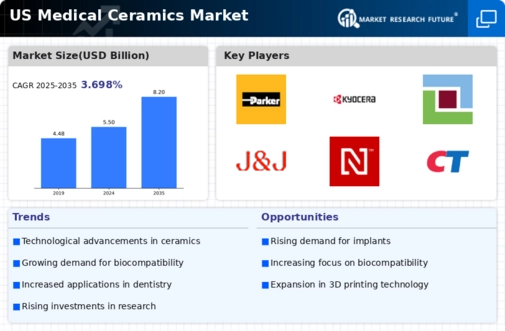Expansion of Orthopedic Applications
The medical ceramics market is witnessing significant growth due to the expansion of orthopedic applications. Ceramics are increasingly utilized in joint replacements, bone grafts, and spinal implants, owing to their excellent mechanical properties and biocompatibility. The orthopedic segment is expected to account for over 40% of the market share by 2025, driven by advancements in surgical techniques and materials science. The increasing prevalence of orthopedic disorders, coupled with an aging population, is likely to further propel the demand for ceramic-based solutions. This expansion in orthopedic applications is a key driver for the medical ceramics market, as it opens new avenues for innovation and product development.
Rising Demand for Biocompatible Materials
The medical ceramics market is experiencing a notable increase in demand for biocompatible materials. This trend is largely driven by the growing need for materials that can integrate seamlessly with human tissue, minimizing the risk of rejection. As healthcare providers prioritize patient safety and comfort, the adoption of bioceramics in applications such as implants and prosthetics is likely to rise. In 2025, the market for bioceramics is projected to reach approximately $2 billion, reflecting a compound annual growth rate (CAGR) of around 8%. This shift towards biocompatibility is reshaping the landscape of the medical ceramics market, as manufacturers innovate to meet these evolving requirements.
Increasing Investment in Research and Development
The medical ceramics market is benefiting from increasing investment in research and development (R&D). Companies are allocating substantial resources to explore new materials and applications, aiming to enhance the performance and functionality of ceramic products. This trend is particularly evident in the development of advanced ceramics that exhibit superior mechanical strength and bioactivity. In 2025, R&D expenditures in the medical ceramics sector are projected to exceed $500 million, reflecting a commitment to innovation. This focus on R&D is likely to drive the medical ceramics market forward, as new discoveries pave the way for improved patient outcomes and expanded product offerings.
Growing Awareness of Minimally Invasive Procedures
The medical ceramics market is growing due to increasing awareness of minimally invasive procedures. These techniques, which often utilize ceramic materials for implants and devices, offer numerous benefits, including reduced recovery times and lower risk of complications. As healthcare providers and patients alike recognize the advantages of minimally invasive options, the demand for ceramic-based solutions is likely to rise. By 2025, the market for minimally invasive surgical devices is expected to reach $10 billion, with ceramics playing a crucial role in this expansion. This growing awareness is a significant driver for the medical ceramics market, influencing product development and market dynamics.
Technological Innovations in Manufacturing Processes
Technological innovations in manufacturing processes are significantly impacting the medical ceramics market. Advanced techniques such as additive manufacturing and precision machining are enabling the production of complex geometries and customized implants. These innovations not only enhance the performance of ceramic materials but also reduce production costs and lead times. As a result, manufacturers are better positioned to meet the specific needs of healthcare providers and patients. The integration of these technologies is expected to contribute to a market growth rate of approximately 7% annually through 2025. This focus on technological advancements is reshaping the competitive landscape of the medical ceramics market.























Leave a Comment